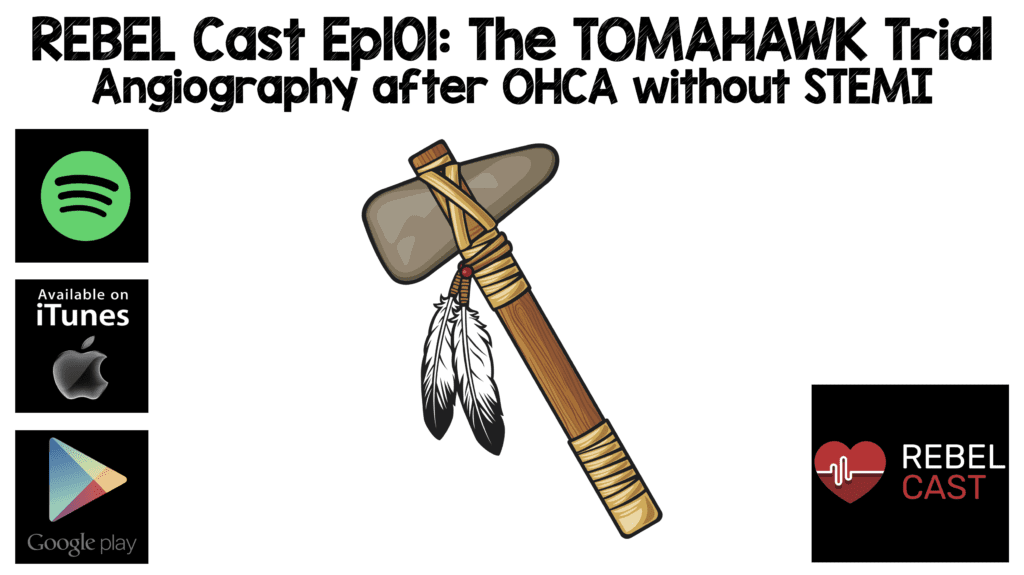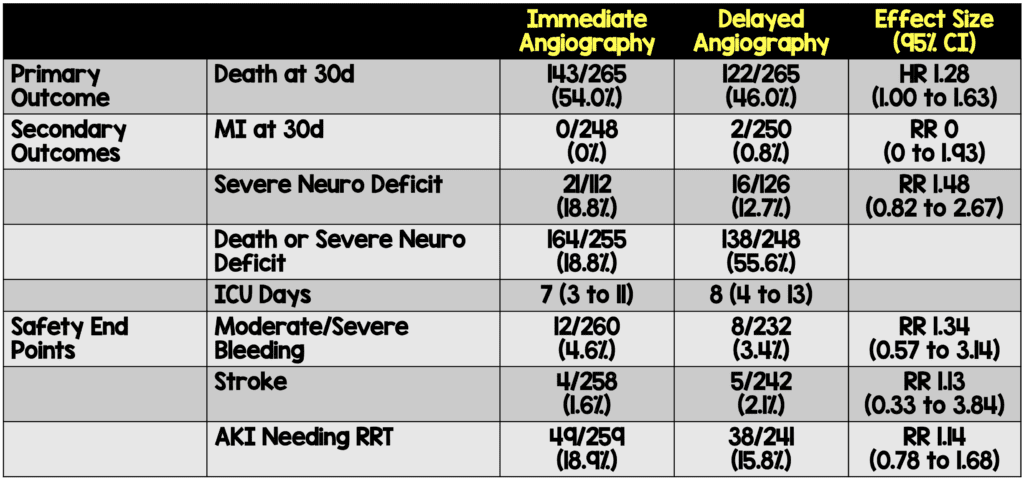
REBEL Cast 101.0 – The TOMAHAWK Trial – Angiography After OHCA Without STEMI
Article: Desch S et al. Angiography After Out-of-Hospital Cardiac Arrest Without ST-Segment Elevation (TOMAHAWK) NEJM 2021. PMID: 34459570
Clinical Question: Does immediate angiography in patients with OHCA with ROSC but no STEMI improve all-cause mortality at 30 days in comparison to a delayed angiography approach?
Population: Adult patients > 30 years of age with ROSC after OHCA of possible cardiac origin without ST-segment elevation. Patients could have both shockable and non-shockable rhythms during their arrest.
Outcomes:
- Primary: All-cause mortality at 30 days
- Secondary:
- Myocardial infarction at 30 days
- Severe neurologic deficit (CPC 3-5)
- Combination of death from any cause or severe neurologic deficit at 30 days
- ICU length of stay
- Safety Endpoints:
- Moderate or severe bleeding
- Stroke
- Acute kidney failure leading to renal-replacement therapy
Intervention: Immediate coronary angiography (with PCI if indicated)
Control: Initial intensive care management followed by selective angiography (delayed angiography group) (minimum 24-hour delay)
Design: International, investigator-initiated, randomized, multicenter, open-label trial.
Excluded:
- ST-segment elevation or LBBB
- No ROSC on hospital admission
- Severe hemodynamic or electrical instability (at clinicians’ discretion)
- Obvious non-cardiac cause (ie overdose, TBI, drowning etc)
- In-hospital cardiac arrest
- Pregnancy (known or suspected)
- Participation in another trial interfering with the research questions of TOMAHAWK
Primary Results
- Enrolled patients from November 2016 through September 2020
- Eligible patients: 558 (31 sites in Germany and Denmark)
- 4 patients did not complete randomization
- 554 patients randomly assigned
- Immediate angiography: 281 (265 analyzed)
- Delayed angiography: 273 (265 analyzed)
- 13/281 (4.6%) in the immediate-angiography group did not undergo immediate catheterization:
- Died before angio: 6
- 22/273 (8.1%) in the delayed-angiography group underwent angiography in the first 24 hours
- Median time form cardiac arrest to ROSC: 15min
- 55.5% of patients with shockable rhythm
- Bystander CPR: 59%
- Median time from arrest to angiography: 2.9 vs 46.9 hours
- Prevalence of coronary artery disease (amongst those getting angiography)
- Immediate-angiography group: 60.7%
- Delayed-angiography group: 72.1%
Critical Results

Subgroups: No improved survival in patients < 65 years of age, patients with a shockable rhythm or those with prolonged time from arrest to ROSC (> 15 minutes)
Strengths:
- Asks a clinically important question
- Primary endpoint is objective
- Baseline characteristics mostly well-balanced between groups (see below for specifics)
- Randomization was well-performed
- Secondary outcomes and safety endpoints were pre-specified
- Included patients with both shockable and non-shockable rhythms
Limitations:
- Death is a hard, objective endpoint which removes subjectivity from assessment. However, neurologically intact survival or neurologic status would have been a better patient-centered outcome.
- Baseline characteristics were mostly well balanced. Coronary artery disease (34.5 vs 40.6%) and prior CABG (8.0 vs 10.6%) were slightly unbalanced – more common in the delayed-angiography group.
- Follow up was excellent (95.7%)
- It is unclear if patients were consecutively enrolled. This may introduce a selection bias.
- The authors set a 12% absolute difference as the goal which may be overly ambitious. However, with no hint of benefit (and possible harm) this limitation is less important in this study.
- Physicians were unblinded which could affect more subjective secondary outcomes.
Discussion:
- The study was designed to have 80% power to detect a 12% difference in the primary outcome. This may be too large a difference to expect from a single intervention.
- Not all cardiac arrest is due to ACS. By immediately going to the cardiac catheterization lab we are potentially delaying identification and treatment of cardiac arrest other than acute coronary syndrome. For example, is PE better identified and treated in the ED or the cath lab?
- Survivorship bias. Patients in the immediate cath group more likely to be alive for cath than those with delayed cath. This creates a selection bias favoring delayed cath. Brain death was the most frequent cause of death among patients in this trial
- Additionally, only 40% of patients found to have coronary culprit lesion in the overall population.
Author Conclusion: “Among patients with resuscitated out-of-hospital cardiac arrest without ST-segment elevation, a strategy of performing immediate angiography provided no benefit over a delayed or selective strategy with respect to the 30-day risk of death from any cause.”
Clinical Take Home Point: In hemodynamic and electrically stable patients with OHCA and no STEMI after ROSC, an immediate-angiography strategy does not appear to improve 30-day mortality. It appears that an approach of intensive care first followed by delayed angiography if clinically indicated is preferred.
References:
- Millin MG et al. Patients without ST elevation after return of spontaneous circulation may benefit from emergent percutaneous intervention: a systematic review and meta-analysis. Resuscitation 2016; 108: 54-60. PMID: 27640933
- Lemkes JS et al. Coronary Angiography after Cardiac Arrest Without ST-Segment Elevation. NEJM 2019; 380(15): 1397-1407. PMID: 30883057
- Elfwen L et al. Direct or Subacute Coronary Angiography in Out-of-Hospital Cardiac Arrest (DISCO) – An Initial Pilot-Study of a Randomized clinical Trial. Resuscitation 2019. [Epub Ahead of Print]
For More Thoughts on This Topic Checkout:
- The Bottom Line: TOMAHAWK
- REBEL Cast: Ep66 – The COACT Trial – Coronary Angiography After Cardiac Arrest Without STEMI
- REBEL EM: DISCO Pilot Feasibility Study -Direct or Subacute Coronary Angiography in OHCA
Post Peer Reviewed By: Salim R. Rezaie, MD (Twitter: @srrezaie)



